Raphanus Raphanistrum: Radical Radish
The Wild Radish has an identity problem. It looks similar to it’s equally peppery cousin, the wild mustard. In fact, it really makes no difference which you have, both are edible, appear the same time and are used the same way. Both grow locally though I think radishs are more common. So, how do you tell them apart?
Wild radishes have singular flowers while mustards have a clump of flowers. The petals of the radish flowers are veined, mustard flowers are not. The seed pods of the radish are segmented, the mustard pods are not. Also wild radishes tend to grow to one or two feet high, maybe three. Wild mustards can four to six feet high. Usually just with a glance you can tell if it is a field of radis or mustards.
Like the mustard the greens of the wild radish make an excellent greens, boiled for 10 minutes or so in plenty of water. They are edible raw but can upset some tummies. In fact, many livestock owners consider the radish and the mustard toxic for the same reason, then again, cows have several stomachs to upset. I have eaten boiled radish greens for years and find them one of the tastiest short-lived plants of spring. That’s the only flaw of the Wild Radish, it’s here for a few weeks and gone. Thus for a few weeks I am busy harvesting, blanching, and freezing as much as I can process.
The blossoms are edible and the seed pods have many uses, from eaten raw to cooked to pickled. Few mention the edibility of wild radish roots. They are quite edible and remind me of kohlrabi in flavor, not a radish. They have vitamins B, C, rutin, and minerals. The tough, outer layer peels off like a separate jacket, often coming off in strips the way colors wrap around a barbershop pole. What is left is the clean, smooth, inner core of the roots. I dice them and cook them in plenty of boiling salted water for 45 minutes. Depending upon their age, they can be occasionally be fibrous but still quite tender and tasty. They do, however, smell like radishes when peeling and can fill the house with a sulfur aroma when cooking. The cooking water may also turn light tan. I like them with salt, pepper and butter. Cooked, they are not peppery at all but rather mild.
Also called the “Jointed Charlock” the Wild Radish’s name is a double take. Raphanus raphanistrum (RA-fah-nus raf-ahn-ISS-trum.) Both come from Raphanis, a Greek word that means appearing quickly. It was the the Ancient Greek name for this vegetable. “Charlock” comes via Old English from the French word “cerlic” the name for the plant.
Green Deane’s “Itemized” Plant Profile
IDENTIFICATION: Flower: Four sepals, four petals, six stamen, 4 long, 2 short, pistil in middle; Flowers tend to be solitary and petals clearly veined. Leaves lobbed, tough, stem round. The pods of wild radish break in fragments to expose the seed while the wild mustard open straight down the middle to expose the seed. Pods stick out around the stem like a spiral staircase. Under a yard high.
TIME OF YEAR: Springtime to summer in northern clims, winter in Florida.
ENVIRONMENT: Well-drained soil, sandy to rich, old pastures, gardens, lawns, roadside
METHOD OF PREPARATION: Leaves as potherb, seeds for spice or flavoring, can use flowers to flavor vinegar. Some young leaves can be used raw in salads. Try a little first. Roots, peeled of outer core then boiled.
Recipe by Pascal:
Take 3 part apple cider vinegar, 2 parts white wine, 1/2 clove garlic, a bit of California Bay Leaf and Italian Spices, red chili and voila! Oh…and a dash of sea salt as well per jar. Canning it for 15 minutes (water-bath canning).

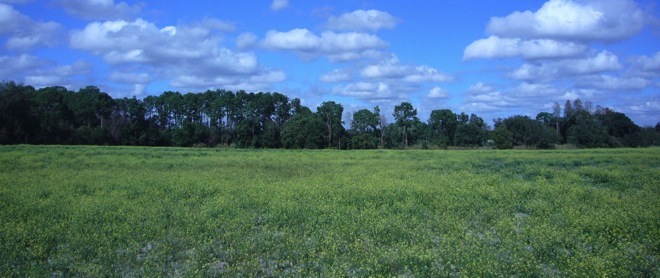
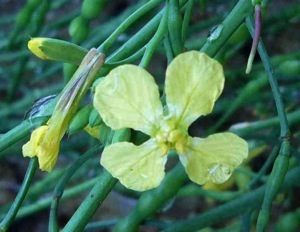
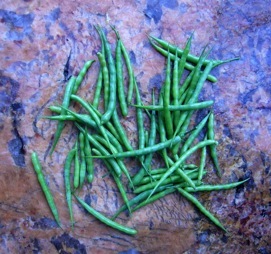
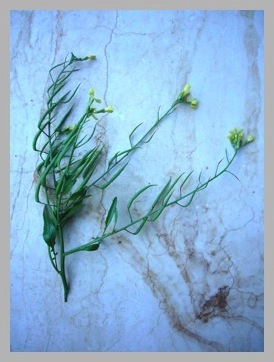

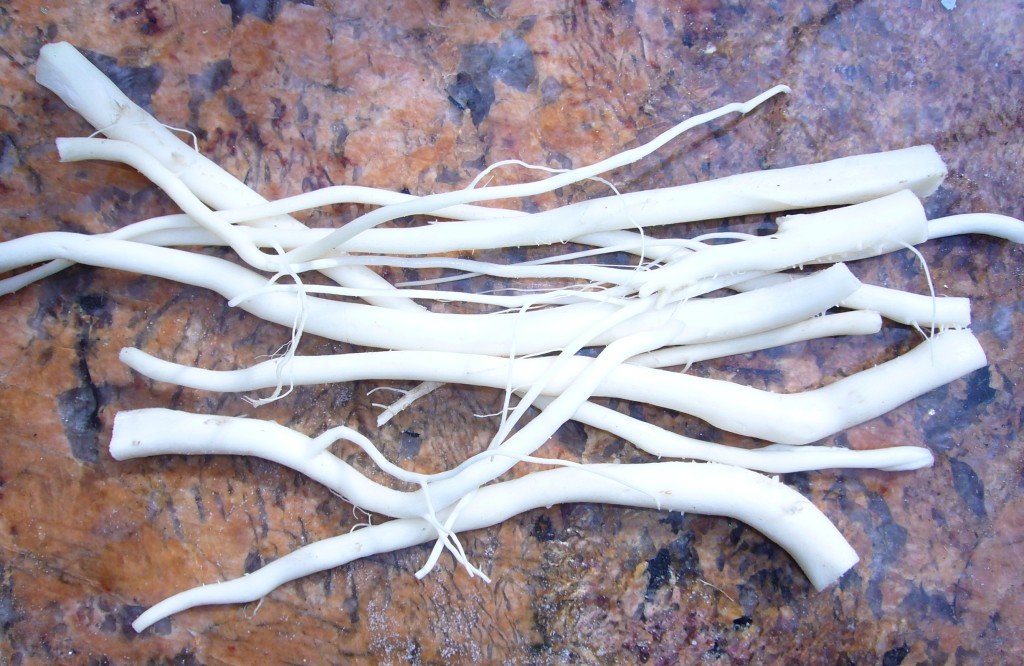
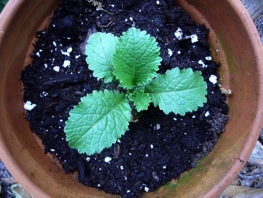
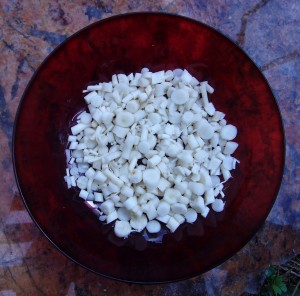
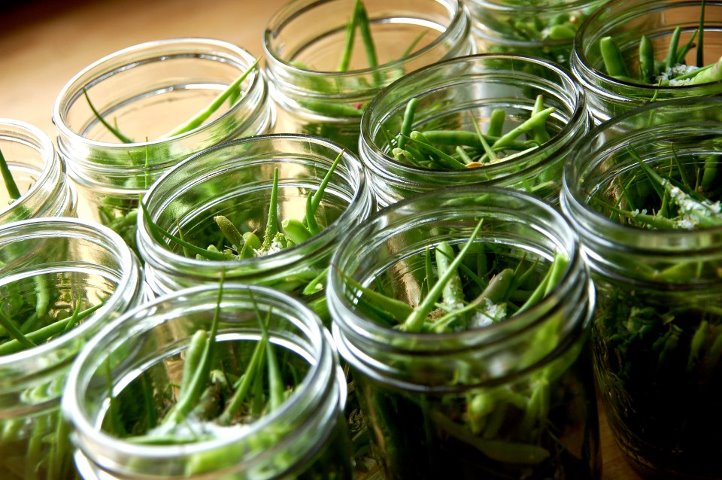

ahhhhh…. found the article you mentioned to me… i will have to investigate now that I know… there is a field that looks about 7 acres or so filled with either radish or wild mustard about 20 miles from here…
great article!!
You should harvest the wild seeds you talk about in your newsletter and then sell them on your website. Not only will you make a few extra bucks, but this is an easy way for people to learn how to recognize these plants as they will be growing in their growing pot from the beginning to the end of its cycle.
Interesting idea.
Yes, it is a great idea, Deane!
I, in particular, would be interested in the wild radish seeds for growing in order to help me to recognize this plant in Indiana.
I would also be interested in buying seeds. Please give this some serious consideration. Best Regards.
IS THERE ANY DANGEROUS LOOK A LIKES IN ORLANDO? I HAVE FOUND SOMETHING in sandy soil – that has white bulbous root that seems easily peeled, semi rough underside leaves in a basil rosette, however the leaves are small in relation to the ones shown in this article, they might be young plants? i dont know. the plants have not bolted yet so i have not had a chance to watch it flower or seed?
Without a picture it is difficult (my new forum is a good place to post such a picture.) Off the top of my head it could be an oak leaf fleabane, maybe a plantago (dwarf plantago) or a senecio that can resemble a mustard/radish but is toxic.
Green Deane, I have just recently discovered your site and forum and am boggled at all the plants I have seen you mention that I have not found anywhere else in years of tinkering with wild edibles.
Do you have a book in the planning… I hope!
No… no paper book in the making… well, I’ve had an idea for one for a couple of years but time is limited…
I would sure love a permanent, tangible copy of all of your plant knowledge. But I am so grateful for the website!
Love your work. Thank you
This autumn, probably October, I had the nicest “crop” of wild radish/mustard, because of a longer than normal period of warm weather, perfect for growth. The leaves were huge and plants came out easily, even in my clay soil. I blanched them for 5 min. in boiling water and then froze many packages. They taste like spinach, but with more body, like maybe turnip greens. Need a recipe? See Deborah Madison’s Vegetarian Cooking for Everyone. I used her Braised Collards or Turnip Greens recipe, with brown butter, onion, garlic, and some red pepper flakes. Delish!
Can you eat the root raw/ fermented such as in kraut or kimchi?
The roots in the greater mustard family are not toxic. They can be strong flavored or have unusual flavors. Some mustard roots give off an ether flavor which is not pleasant.
We have wild mustard and wild radish as well as numerous other edible greens here in KY where I reside, to any and all interested, I would be more than happy to distribute seeds to any of these plants out to anyone who has interest in growing them, happy gardening, Jason.
I Jason. Do you still have wild mustard and wild radish seeds? Maybe wild cabbage too? I am interested in buying some to try. Thanks
I am interested in wild radish seeds. We used to get them from oat fields, but no one is planting oats here anymore. Please let me know if you have any for sale. Thank you.
I am interested in finding wild radish seed. I live in Canada so do not know if it is possible to send them here.